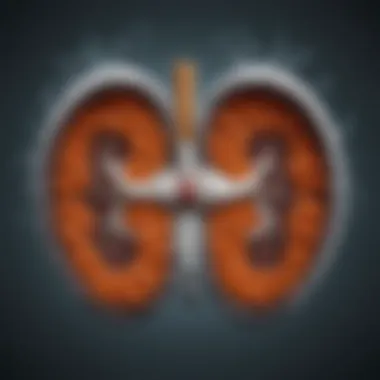Understanding Bladder Cancer Risk After Quitting Smoking


Intro
The topic of bladder cancer and smoking has received considerable attention in medical research. Understanding the implications of quitting smoking on bladder cancer risk is vital. This exploration includes biological mechanisms and environmental factors that contribute to bladder health. Quitting smoking can have immediate and lasting effects, but the nuances behind these effects can be complex.
In this article, we will delve into the research conducted in this area. We will provide insights into risk factors, compare recent findings with established knowledge, and aim to equip readers with comprehensive understanding of bladder cancer post-smoking cessation.
Research Overview
The research surrounding smoking cessation and bladder cancer presents interesting findings. Studies consistently indicate that smoking is a significant risk factor for bladder cancer. However, after quitting, the risk may not remain static. The following subsections provide further details on key findings and methodologies employed in this research area.
Summary of Key Findings
- Decreased Risk Over Time: Studies show that the risk of bladder cancer decreases after quitting smoking, but it may take years for levels to approach those of non-smokers.
- Biological Mechanisms: The carcinogenic compounds in tobacco can damage the bladder lining. Quitting smoking allows the body to heal.
- Other Risk Factors: Factors such as age, gender, and chemical exposure also play a role, complicating the relationship between smoking cessation and bladder cancer risk.
Methodologies Employed
Researchers employed both observational studies and clinical trials to gather data. For example, a longitudinal study tracked a group of smokers over several years to assess changes in cancer incidence related to smoking cessation.
"Understanding how the body reacts to smoking cessation is crucial for informing public health strategies."
In-Depth Analysis
This section provides a detailed examination of how quitting smoking influences bladder cancer risk, considering various factors at play.
Detailed Examination of Results
Recent data has suggested that individuals who quit smoking reduce their risk of bladder cancer significantly over time. The results show a correlation between the duration of cessation and reduced incidence of bladder cancer. Those who quit for 5 years saw substantial decreases, whereas those who quit for 10 years experienced even lower risks.
Comparison with Previous Studies
When comparing recent research with prior studies, it becomes clear that earlier research often underestimated the timeline for risk reduction. Previous models may not have fully accounted for variables such as diet and environmental factors. Modern studies utilize more refined methodologies, revealing a clearer picture of risk and promoting further discourse on effective prevention strategies.
Prelude to Bladder Cancer
Bladder cancer is a significant health concern that warrants attention due to its rising incidence rates and complex relationship with lifestyle factors such as smoking. Understanding bladder cancer not only informs individuals about the risks but also emphasizes the importance of early detection, particularly in populations with a history of tobacco use. This section will delve into essential components including the definition, epidemiology, types, and common symptoms associated with bladder cancer.
Definition and Epidemiology
Bladder cancer originates in the tissues of the bladder, an organ that stores urine. It can manifest in various forms, affecting individuals differently. According to the American Cancer Society, bladder cancer is one of the most common cancers in the United States. The median age of diagnosis is around 73 years.
Epidemiologically, risk factors include smoking, chronic bladder irritation, and exposure to certain chemicals. The incidence of bladder cancer is notably higher in males than in females and is largely seen in developed countries. Factors such as age, gender, and lifestyle choices play crucial roles in the epidemiological landscape of bladder cancer, influencing prevention strategies tailored to at-risk populations.
Types of Bladder Cancer
Bladder cancer can be classified into several types, each with distinct characteristics. The most prevalent forms include:
- Transitional Cell Carcinoma (TCC): This is the most common type, accounting for approximately 90% of cases. It arises from the epithelial cells lining the bladder.
- Squamous Cell Carcinoma: This type is less common and typically develops in regions exposed to chronic irritation.
- Adenocarcinoma: This rare type of bladder cancer originates from glandular cells and represents a small percentage of cases.
Understanding these types is essential for both prognosis and treatment options.
Symptoms and Diagnosis


The symptoms of bladder cancer can vary, but common indicators include:
- Blood in urine (hematuria)
- Frequent urination
- Painful urination
- Lower back pain
Diagnosing bladder cancer typically involves a combination of urine tests, imaging studies, and cystoscopy, where a thin tube is inserted into the bladder for direct visualization. Early detection can significantly enhance treatment outcomes, making awareness of symptoms vital for timely medical intervention.
Early diagnosis remains critical for improving survival rates in bladder cancer.
This comprehensive understanding of bladder cancer sets the stage for discussions on the impact of smoking and the potential benefits of cessation. Recognizing the risk factors associated with bladder cancer, particularly in former smokers, will enhance the understanding and management of this disease.
Impact of Smoking on Bladder Health
The impact of smoking on bladder health is significant and multifaceted. Tobacco contains numerous carcinogens that contribute to various bladder conditions, including cancer. Understanding this relationship is crucial for former smokers who seek to mitigate their risk after quitting. By comprehending the mechanisms involved, and examining statistical correlations, individuals can make more informed decisions about their health moving forward.
Mechanisms of Risk
Smoking introduces harmful substances into the body, affecting cellular processes in the bladder. When tobacco smoke is inhaled, the harmful chemicals are absorbed into the bloodstream. These chemicals are then transported to the bladder through the urine. Over time, repeated exposure leads to cellular damage and inflammation in the bladder lining.
- Carcinogenic Compounds: The primary concern is the presence of carcinogenic compounds such as benzidine and aniline. These substances can cause mutations in DNA, ultimately leading to cancer.
- Chronic Inflammation: Smoking can induce a state of chronic inflammation in the bladder. This inflammation can promote tumor growth as inflammatory cells release substances that can damage nearby tissues.
- Oxidative Stress: Tobacco smoke causes oxidative stress, which results in the formation of free radicals. These free radicals can further damage cellular structures and promote malignancies.
These mechanisms illustrate how smoking can create a conducive environment for bladder cancer development. Understanding these risks is essential in evaluating the long-term benefits of quitting smoking.
Statistical Correlation with Bladder Cancer
Numerous studies have established a strong statistical correlation between smoking habits and increased bladder cancer incidence. Smokers are far more likely to develop bladder cancer compared to non-smokers.
- Incidence Rates: Research indicates that smokers are about three times more likely to be diagnosed with bladder cancer than those who have never smoked. This statistic underscores the gravity of smoking as a risk factor.
- Duration and Intensity: The risk of bladder cancer is often related to the duration and intensity of smoking. Those who smoke heavily over many years face substantially higher risks.
- Gender Differences: Some empirical studies show gender differences in the correlation. Men who smoke are at a greater risk than women, although both genders are adversely affected.
"Tobacco use remains the leading preventable cause of cancer. The implications for bladder health are profound, and quitting smoking significantly improves outcomes."
Understanding these statistical correlations can inform health policies and motivate individuals to quit smoking. It also serves as a basis for public health messages aimed at reducing smoking prevalence and promoting bladder health.
Smoking Cessation: Immediate Effects
Quitting smoking is a significant milestone for individuals. It is not just about stopping a habit; it is about initiating a series of biological and chemical changes within the body. Understanding these immediate effects helps illustrate the potential benefits of cessation, especially concerning bladder cancer risk. The relationship between smoking and cancer is well established, but the path to recovery and the potential for risk reduction can be transformative.
Biological Changes Post-Cessation
When a person stops smoking, the body begins to repair itself. This process starts almost immediately. Within 20 minutes of quitting, heart rate and blood pressure drop to normal levels. Over the next hours, carbon monoxide levels decrease, leading to improved oxygenation of tissues.
Research indicates that within weeks, the body's ability to clear mucus from lungs improves. This is crucial, as reduced lung function can relate to systemic inflammation, impacting cancer risks in various organs, including the bladder. One of the key aspects of cessation is the gradual restoration of immune function, which can adapt favorably to fight off potential cancerous cells.
Additionally, changes in urinary biomarkers may reflect improvements in bladder health. The risk of bladder cancer diminishes as the body clear carcinogens accumulated from smoking. The following points highlight the impact of biological shifts post-cessation:
- Improved circulation: Enhanced blood flow can lead to better nutrient delivery and toxin removal.
- Lung recovery: Enhanced lung function reduces overall inflammation, which can affect bladder health.
- Hormonal balance: Smoking can influence hormone levels linked to cancer development; quitting restores balance.
Reduction in Carcinogenic Exposure
Quitting smoking has immediate implications for reducing exposure to toxins. Cigarette smoke contains numerous carcinogens known to promote cancerous growth. By stopping smoking, a person significantly lowers their contact with these harmful substances.
The bladder acts as a storage space for urine, which contains waste products, including those derived from chemicals found in cigarettes. The cessation of smoking minimizes the influx of these toxins. Notably, this reduction in carcinogens circulates through the body. This includes substances that may linger in the urinary tract, which can contribute to bladder cancer development over time. Points worth considering include:
- Elimination of harmful chemicals: Substances such as benzene and formaldehyde, which are present in tobacco, are no longer introduced into the body.
- Altered urinary composition: As dangerous chemicals diminish from the system, the chances of developing bladder abnormalities are reduced.
- Increased hydration: Many former smokers tend to hydrate more, promoting efficient urine flow and helping flush out residual toxins.


Studies indicate quitting smoking decreases bladder cancer risk gradually, with significant reductions observed over several years post-cessation.
Long-Term Health Outcomes of Quitting Smoking
Quitting smoking is one of the most significant health decisions a person can make. The long-term health outcomes of this decision are crucial, especially in the context of bladder cancer. Understanding these outcomes helps shed light on how cessation impacts not just overall health but specifically the risk of developing bladder cancer over time. The benefits of quitting are broad-ranging and include improvements in respiratory health, cardiovascular function, and potentially reduced cancer risks, including bladder cancer.
Time Frame for Risk Reduction
The timeline for reduced risk of bladder cancer after quitting smoking varies among individuals. Research indicates that significant changes in risk can begin shortly after cessation. Some studies suggest that within five years of quitting, a former smoker's risk of developing bladder cancer may be reduced by nearly 50% compared to those who continue to smoke. However, this time frame may depend on several factors, including:
- Duration of previous smoking habit: Longer smoking durations may lead to a slower reduction in risk.
- Age at cessation: Quitting at a younger age is generally associated with a more favorable outcome regarding cancer risk.
- Lifestyle factors: Continued exposure to other carcinogens may still pose a risk.
Furthermore, after 10 to 15 years of cessation, the risk of bladder cancer can approach that of never-smokers. The gradual decline in risk illustrates the body's ability to recover and restore health benefits over time after quitting.
Effects on Bladder Cancer Risk Over Time
The effects of quitting smoking on bladder cancer risk further highlight the importance of cessation. As time progresses post-cessation, the body continues to eliminate harmful toxins, contributing to a lower risk profile. Key observations include:
- Carcinogen Clearance: Quitting smoking initiates a gradual detoxification process, decreasing the concentrations of carcinogens in the bladder.
- Bladder Cell Regeneration: The cells lining the bladder can regenerate, thereby diminishing the likelihood of cancerous development due to prior exposure to tobacco toxins.
- Immune System Improvement: Cessation enhances immune function, offering better surveillance against cancer formation.
"The benefits of smoking cessation extend beyond immediate health improvements, with significant long-term risk reductions for diseases like bladder cancer."
Role of Other Risk Factors
The examination of bladder cancer risk post-smoking cessation requires more than just focusing on smoking habits. Multiple factors contribute to an individual's risk profile for developing bladder cancer, even after quitting. Understanding these elements can inform prevention strategies for those who have stopped smoking. This section elucidates some of these key risk factors, namely genetic predispositions, environmental exposures, and dietary influences. Each of these aspects plays a crucial role in shaping an individual’s risk after they quit smoking.
Genetic Predispositions
Genetic predispositions significantly influence the likelihood of developing bladder cancer. Certain individuals carry inherited gene mutations that may make them more susceptible to the disease, regardless of their smoking history. For instance, mutations in DNA repair genes can impair the body’s ability to correct cellular damage. This inefficiency may render individuals more vulnerable to carcinogens present in the environment and even those from past tobacco use. Snps, or single nucleotide polymorphisms, have also been studied, revealing that variations in genes associated with drug metabolism can affect cancer susceptibility. Considering family history of bladder cancer can also serve as an indicator of potential risk for individuals, particularly for those with a familial tendency toward various cancers.
Environmental Exposures
Environmental exposures have long been recognized as significant contributors to bladder cancer risk. Common carcinogens, such as those found in certain industrial settings, may linger in a person's environment long after quitting smoking. Chemicals like aniline dyes, aromatic amines, and various solvents have been linked to increased bladder cancer rates. The degree of risk is often related to the duration and intensity of exposure. Additionally, occupational hazards deserve attention. People working in specific industries, like rubber manufacturing or chemical plants, face heightened risks due to continued exposure to harmful substances. For former smokers, it is vital to assess their environments and seek reductions in exposure to these toxins, as cumulative risks may compound their overall susceptibility.
Dietary Influences
Diet plays a multifaceted role in cancer prevention and overall health. Certain nutrients and dietary patterns can either mitigate or exacerbate the risk of bladder cancer. A diet rich in fruits and vegetables is typically associated with lower cancer risks, offering antioxidants and phytochemicals that may protect against cellular damage. On the other hand, diets high in processed meats or refined carbohydrates might contribute to a higher risk, encouraging inflammation and promoting cancer growth.
Moreover, hydration is a crucial aspect. Adequate water intake dilutes potential carcinogens in the bladder, reducing the risk of irritation and inflammation. Observational studies suggest that those who drink more fluids have a reduced risk of bladder cancer. Individuals who have quit smoking should consider nutritional adjustments, emphasizing a balanced diet that supports not just bladder health but overall well-being.
Consideration of genetic, environmental, and dietary factors is essential when assessing bladder cancer risk after quitting smoking. This comprehensive view helps devise effective prevention strategies.
Current Research Findings
Understanding the recent research findings is crucial in addressing the risk of bladder cancer post-smoking cessation. It bridges the gap between the theoretical knowledge of cancer mechanisms and practical clinical implications. Today’s studies are shedding light on how former smokers navigate their health journeys, informing both patients and healthcare providers about risks and preventive measures. This section will outline significant insights drawn from the latest studies, demonstrating the evolving understanding within this field.
Recent Studies on Smoking and Bladder Cancer
Recent studies have focused on understanding how quitting smoking influences the risk of developing bladder cancer. Notably, research has shown a substantial reduction in risk as time passes after cessation. According to a nationwide study published in Cancer Epidemiology, Biomarkers & Prevention, former smokers can experience a significant decline in their bladder cancer risk. Among those who have not smoked for over 10 years, the risk can decrease to levels comparable to non-smokers. These findings emphasize the dynamic nature of cancer risk and the potential for recovery post-cessation.
Additionally, recent meta-analyses have clarified the relationship between the duration of smoking and bladder cancer incidence. Studies reveal that heavy smokers are at a higher risk compared to light smokers. More precisely, individuals who smoked over 20 cigarettes daily had a risk multiplier of approximately two to four times higher than non-smokers. As a result, understanding the specifics of smoking habits plays a critical role in interpreting personal risk comprehensively.


"Quitting smoking can significantly lower bladder cancer risk, showcasing the benefits of cessation over time."
Cohort Studies and Their Insights
Cohort studies provide valuable longitudinal insights into bladder cancer risks among smokers and former smokers. These studies typically follow a group of individuals over many years, tracking their smoking habits and any subsequent health issues, including bladder cancer. In a notable cohort study conducted by the American Journal of Epidemiology, researchers followed participants for decades, collecting data on smoking status, age, and the incidence of bladder cancer.
The insights gained from such research are multifaceted. First, these studies confirm that the period of smoking prior to quitting is a significant predictor of bladder cancer risk. Those who quit smoking earlier in life demonstrate a much lower likelihood of developing cancer in later years, highlighting the importance of early intervention. Additionally, factors like age and gender are shown to influence risk levels, with older adults and men having higher susceptibility to bladder cancer.
Second, cohort studies often illustrate the cumulative effect of smoking. Data indicates that every year of smoking correlates with an increased risk of bladder cancer. However, quitting at any stage markedly reduces this risk over time. Cohort studies serve to underscore the fact that while the numbers may suggest a heightened risk due to prior smoking, there is a pathway to significant risk reduction through smoking cessation.
In summary, the findings from recent studies and cohort analyses provide a clearer picture regarding the implications of quitting smoking on bladder cancer risks. The gradual onset of reduced risk after cessation is a potent reminder of the benefits of quitting, both for health improvement and quality of life.
Preventive Strategies for Former Smokers
Quitting smoking is a significant step toward reducing the risk of various cancers, including bladder cancer. However, the journey does not end with cessation. This section examines preventive strategies that former smokers can adopt to further diminish their chances of developing bladder cancer. A multi-faceted approach is critical; it encompasses regular screenings, lifestyle modifications, and awareness of personal health.
Regular Screening Recommendations
Regular screening for bladder cancer is a vital preventive strategy for those who have quit smoking. Evidence indicates that early detection can greatly enhance treatment options and outcomes.
For former smokers, guidelines suggest a baseline screening should occur around five years after cessation. This timeline considers the extended latency period of bladder cancer development post-smoking.
It is essential to understand what the screening process entails:
- Cystoscopy: This involves inserting a thin tube with a camera through the urethra to view the bladder lining directly.
- Urine tests: These can help identify cancerous cells or other abnormalities.
Regular follow-ups may be recommended based on individual risk factors, including age, duration of smoking, and family history of bladder cancer. Each person should maintain open communication with their healthcare provider to personalize a screening schedule.
"Regular screenings can lead to early detection, which is crucial in improving health outcomes."
Lifestyle Modifications
Beyond testing, lifestyle modifications play a crucial role in reducing bladder cancer risk and enhancing overall health. Even though quitting smoking is a significant factor, adopting healthy habits can further support recovery and minimize the risk of cancer-related complications.
Here are some strategies that can be beneficial:
- Nutrition: A balanced diet rich in fruits and vegetables can boost the immune system. Some studies indicate that a high intake of antioxidants may help combat cancer risk.
- Hydration: Drinking plenty of water may dilute harmful substances in the bladder and reinforce urinary health.
- Physical activity: Regular exercise bolsters the immune system and may help in maintaining a healthy weight, which is crucial since obesity can also be a risk factor for bladder cancer.
- Avoiding irritants: It is advisable to limit exposure to potential bladder irritants, such as certain chemicals and artificial dyes found in some foods.
Overall, a proactive approach that combines regular screenings and lifestyle changes can significantly enhance the well-being of former smokers and contribute to long-lasting health improvements.
End: The Path Forward
The topic of bladder cancer risk after quitting smoking holds considerable importance in both public health discourse and individual health journeys. As smoking remains a significant risk factor for various cancers, understanding the mitigating effects of cessation is essential. This article has detailed the complexities surrounding bladder cancer, emphasizing how biological changes and environmental factors interweave to affect health outcomes post-cessation.
Summarizing these key findings sheds light on the fact that while quitting smoking can markedly decrease the risk of developing bladder cancer, the timeline for risk reduction varies among individuals. For example, some studies indicate that the risk declines significantly within just a few years, whereas others suggest a longer period is required for the risk to approach that of non-smokers. Thus, the path forward involves engaging healthcare professionals to establish personalized monitoring plans for former smokers, focusing not only on the cessation of smoking but also on continuous health evaluations.
Summarizing Key Findings
The key findings from this exploration into the risk of bladder cancer after quitting smoking are crucial for forming a well-rounded understanding. They include:
- Immediate Biological Changes: Quitting smoking initiates various biological processes that support overall health improvements. The lungs begin to heal, and circulation improves, which is beneficial for all organ systems, including the bladder.
- Reduced Carcinogenic Load: Tobacco smoke introduces a myriad of known carcinogens into the body. Once a person quits smoking, they start to reduce their exposure to these harmful substances, directly impacting their cancer risk.
- Time Frame for Risk Reduction: Studies reveal that the risk of bladder cancer decreases gradually after quitting. Most evidence indicates that substantial risk reduction occurs over a decade or more of being smoke-free.
- Influence of Other Risk Factors: Genetics, environmental exposures, and lifestyle choices contribute significantly to bladder cancer risk. Therefore, it is only through a multifactorial approach that former smokers can gain a comprehensive view of their health.
"Quitting smoking is the most important step an individual can take to improve their long-term health, but understanding the timeline and factors involving bladder cancer is equally vital for former smokers."
Future Research Directions
As we look to the future, several research directions can enhance our understanding of the interplay between smoking cessation and bladder cancer risk. These include:
- Longitudinal Studies: There is a pressing need for more extensive longitudinal studies tracking former smokers over different time frames to assess long-term changes in bladder health. Understanding these patterns could better inform public health recommendations.
- Biomarkers: Research into specific biomarkers that indicate bladder cancer risk could be transformative. Identifying early indicators could guide screening and prevention efforts for susceptible populations.
- Cohort Diversification: Engaging diverse populations in studies will help researchers understand how varying genetic backgrounds and environmental exposures impact bladder cancer risk post-smoking.
- Preventive Strategies Evaluation: As more former smokers seek methods to decrease their cancer risks, evaluating the effectiveness of various preventive strategies, such as dietary changes and exercise, will provide valuable insights.















